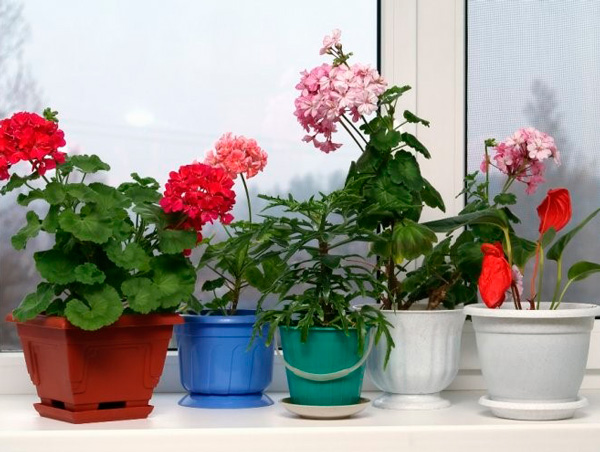Cyclamen
 Cyclamen is a houseplant belonging to the family of primrose.
Cyclamen is a houseplant belonging to the family of primrose.
Homeland – The Mediterranean coast of southern Europe. Cyclamen grows from fibrous round or flattened tubers. From the upper tuber cavity, flowers and heart-shaped leaves are formed.
Cyclamen flowers have a variety of colors: red, white, pink, yellowish, etc.
With good care, cyclamen can live for several years and form more and more numerous flowers every year.
Cyclamens with many flowers and buds begin to appear in flower shops from the first days of September. When buying, make sure that the leaves are not damaged, the color of the leaves is juicy and saturated. It is better to buy cyclamen with flowers that have not yet opened. The tuber of the plant should protrude 2-4 cm above the ground.
If the color of the cyclamen leaves is pale, this is a sign of excessive watering. When overflowing, tubers and petioles of cyclamen can easily rot. At the first signs of waterlogging, cyclamen is placed in a dry, ventilated place, damaged leaves should be removed. The cyclamen is watered by pouring water into the pan.
If the cyclamen has twisted and yellowed leaves – this is a sign of too dry ambient air, high temperature. Cyclamen should be kept moist at a temperature of 15-18 ° C
Two types of cyclamens are common in room culture: Persian cyclamen (Cyclamen persicum) and European cyclamen (Cyclamen europaeum), but others can also be grown.
Persian cyclamen
Cyclamen persicum
Persian cyclamen is a perennial tuberous plant of the primrose family. Cyclamen with heart-shaped dark green leaves. Persian cyclamen blooms from autumn to spring. In summer, it is at rest.
Temperature mode
the temperature should not be too high, cyclamen grows well in cool rooms. Summer temperature for cyclamen is 15-18 ° С, winter -12-16 ° С
Lighting
bright, scattered. In winter, it is recommended to use additional artificial lighting
moderate.
Watering
In autumn and winter, the soil is kept moist. It is recommended to water cyclamen by immersing the pot with it in a container filled with water so that the earthen lump is saturated with moisture from below. Water should not stagnate, otherwise the roots of cyclamen may rot. During flowering, cyclamen loves high humidity. To ensure constant air humidity, it is useful to place a cyclamen pot on a wet pebble tray. At the end of flowering, when the leaves and flowers begin to fade, watering is shortened to bring cyclamen to rest. In spring and summer, the soil is kept moist only around the tuber. Do not water the cyclamen too much, and do not wait until it is completely dry.
Transfer
Cyclamen blooms much better when the roots are in a slightly constricted state. Cyclamen is transplanted only when the roots are very densely filled the pot. The tuber is planted so that its upper part protrudes 3-4 cm above the surface of the soil. A mixture of peat, garden soil, sand and humus is used for planting (1: 1: 1: 1)
Propagation of cyclamen by seeds
The optimum sowing date is the end of August, September. Before sowing, the seeds are soaked for a day in warm water (for best results, you can use a growth regulator, for example, zircon). Cyclamen seeds are sown in pots with leaf and peat soil, in equal proportions. Top seeds sprinkled with a layer of earth 0.5 -1 cm, watered. The greenhouse is placed in a warm and dark place or covered with a dark film. Check the soil to make sure it is in a slightly damp condition. At a temperature of 20 ° C, the first leaflet appears after 3-5 weeks. About a month passes from the first leaflet to the second. It is advisable to plant the seeds in separate pots in which cyclamen can not be touched the first year of development. The second reason for sowing cyclamen in separate pots is the uneven seed germination. Cyclamen seeds sometimes sprout with a difference of 1 month. Before the first leaf appears, the pots should be located in a dark place, and sprouted – it is advisable to expose to light. The soil in small cyclamens is kept moist, and the temperature should be 15-18 ° C. Gradually, seedlings grow and fill the pots. Cyclamen is transplanted only when the roots fill the pot very tightly.
2 months after planting
cyclamen 6 months after planting
cyclamen flowering cyclamen
(8 months after planting)
European cyclamen
Cyclamen europeum
The homeland of European cyclamen is Southern and Central Europe. Evergreen tuberous plant. The tubers are large, spherical or elongated. The stalk is shortened.
The leaves of cyclamen are rounded heart-shaped, collected in a socket. The leaf blade is about 4 cm in diameter, dark green above, with irregular silver spots, dark red below. Cyclamen flowers are small, fragrant, lilac-pink. The cyclamen blooms in spring and autumn.




